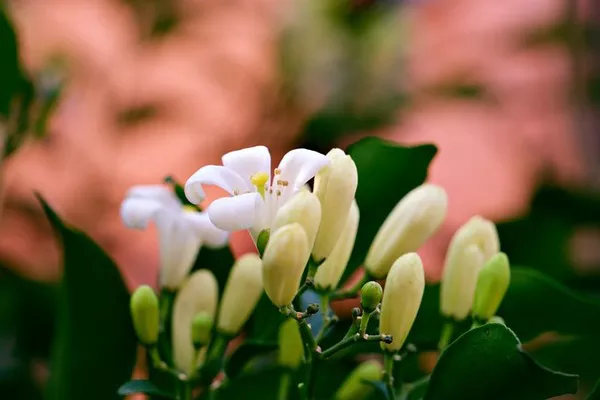Jasmine, with its delicate and fragrant blossoms, is a beloved addition to gardens and indoor spaces around the world. However, it can be disheartening when your jasmine fails to produce those beautiful, aromatic flowers you were expecting. There are various reasons why your jasmine may not be flowering as expected, and understanding these factors is crucial to encourage blooming. In this article, we will explore the common causes behind non-flowering jasmine and provide practical solutions to help you revive your plant’s blooming potential.
See Also: Exploring the Beauty of Jasmine Flowers: A Full Overview
Lack of Adequate Sunlight
One of the most common reasons for non-flowering jasmine is insufficient sunlight. Jasmine plants thrive in bright, indirect sunlight or full sun, depending on the species. If your jasmine is not receiving enough light, it may allocate its energy primarily to growth rather than flowering.
Solution: Ensure your jasmine receives at least 6 to 8 hours of sunlight per day. If growing indoors, place it near a south or west-facing window to maximize exposure to natural light. Outdoor jasmine plants should be planted in well-draining soil in a sunny location.
Improper Pruning
Pruning is essential for maintaining the shape and health of your jasmine plant, but improper pruning can hinder flower production. Overzealous pruning or trimming at the wrong time of year can remove flower buds and reduce the plant’s ability to bloom.
Solution: Prune your jasmine carefully during the appropriate season, typically after flowering has ceased in late winter or early spring. Trim back only the dead or overgrown branches and avoid cutting into the main stems where flower buds are likely to form.
Nutrient Deficiencies
Jasmine plants require essential nutrients like nitrogen, phosphorus, and potassium to support their growth and flower production. A lack of these nutrients can lead to poor flowering or a complete lack of blooms.
Solution: Regularly feed your jasmine with a balanced fertilizer formulated for flowering plants. You can also incorporate organic matter such as compost or well-rotted manure into the soil to improve its nutrient content. Be cautious not to over-fertilize, as this can harm the plant.
Inadequate Watering
Both overwatering and underwatering can hinder jasmine’s ability to produce flowers. Overwatering can lead to root rot, while underwatering can stress the plant and limit its blooming potential.
Solution: Maintain a consistent watering schedule, allowing the top inch of soil to dry out between waterings. Adjust the frequency of watering based on the season and climate. Potted jasmine plants may require more frequent watering than those planted in the ground.
Unsuitable Soil Conditions
Jasmine plants prefer well-draining soil that is slightly acidic to neutral. If the soil is too compacted or retains too much moisture, it can lead to root problems and inhibit flowering.
Solution: Ensure your jasmine is planted in well-draining soil. Amending the soil with perlite or compost can improve drainage. Regularly check the soil’s moisture level to prevent waterlogged conditions.
Temperature Extremes
Jasmine plants are sensitive to temperature fluctuations. Extremely hot or cold weather can stress the plant and reduce flowering.
Solution: If you live in an area with extreme temperatures, consider planting your jasmine in a sheltered location or providing temporary protection during severe weather conditions. Indoor jasmine plants should be placed away from drafts and heating or cooling vents.
Lack of Proper Support
Certain jasmine varieties, such as climbing or vining types, require a support structure like a trellis or fence to encourage proper growth and flowering. Without adequate support, these plants may not reach their full blooming potential.
Solution: Install a trellis or support structure near your jasmine plant to provide it with a stable framework for climbing. Train the vines to grow along the support to allow for better air circulation and sun exposure.
Age of the Plant
Jasmine plants typically produce more flowers as they mature. Younger plants may take some time to establish their root system and start blooming consistently.
Solution: Be patient and give your young jasmine plant time to grow and develop. With proper care and attention to its needs, it will eventually reward you with beautiful blooms as it matures.
Pest and Disease Issues
Pest infestations or diseases can stress jasmine plants, diverting their energy away from flowering. Common pests that affect jasmine include aphids, mealybugs, and spider mites.
Solution: Regularly inspect your jasmine plant for signs of pests or diseases, and take prompt action to address any issues. Use organic pest control methods or insecticidal soap to manage pest infestations, and prune affected parts of the plant to prevent the spread of diseases.
Inadequate Pruning and Training
Certain jasmine varieties, especially the vining types, benefit from proper pruning and training to encourage flowering. Failure to provide this necessary maintenance can result in a tangled and unproductive plant.
Solution: Learn about the specific pruning and training requirements of your jasmine variety and follow best practices to promote healthy growth and abundant flowering. This may involve removing dead or tangled branches, training the plant to climb a trellis, or shaping it to maintain a desired form.
Conclusion
Jasmine’s enchanting fragrance and delicate blooms make it a sought-after addition to any garden or indoor space. However, when your jasmine plant fails to produce flowers, it can be frustrating. By addressing common issues such as insufficient sunlight, improper pruning, nutrient deficiencies, watering problems, soil conditions, temperature extremes, lack of support, plant age, and pest or disease infestations, you can troubleshoot the non-flowering problem and bring your jasmine back to its full blooming potential. With the right care and attention, your jasmine will reward you with a profusion of fragrant blossoms year after year.


